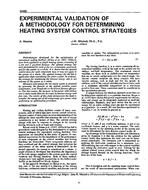Description
Methodologies developed for the optimisation of centralised cooling facilities (Braun et al. 1987, 1989a,b) have been applied to a simple heating system consisting of a fan and a gas-fired furnace. The optimal strategy has been determined for each of the two components separately and for the system as a whole. It is shown that the optimal control laws for each component may or may not apply to the system as a whole. The optimal strategy for the fan is applicable when considering the entire system. In contrast, the strategy for minimising the furnace energy only is not relevant to the system as a whole. Minimum total energy for the entire system is obtained by operating the furnace at the highest possible water temperature, even though this is the lowest furnace efficiency. For this system, the increase in fan power with air flow rate is more costly than the decrease in furnace energy with flow rate. The results of this study demonstrate the need to consider the energy use of all components of a system when performing an optimisation procedure.
KEYWORDS: centralised services, experiment, calculating, heating, cooling, controls, optimisation, gas fired boilers, fans, components, energy consumption, water temperature, air flow rate, efficiency
Citation: ASHRAE Transactions, vol.97, pt. 2, Indianapolis, IN 1991
Product Details
- Published:
- 1991
- Number of Pages:
- 7
- File Size:
- 1 file , 870 KB
- Product Code(s):
- D-17938




